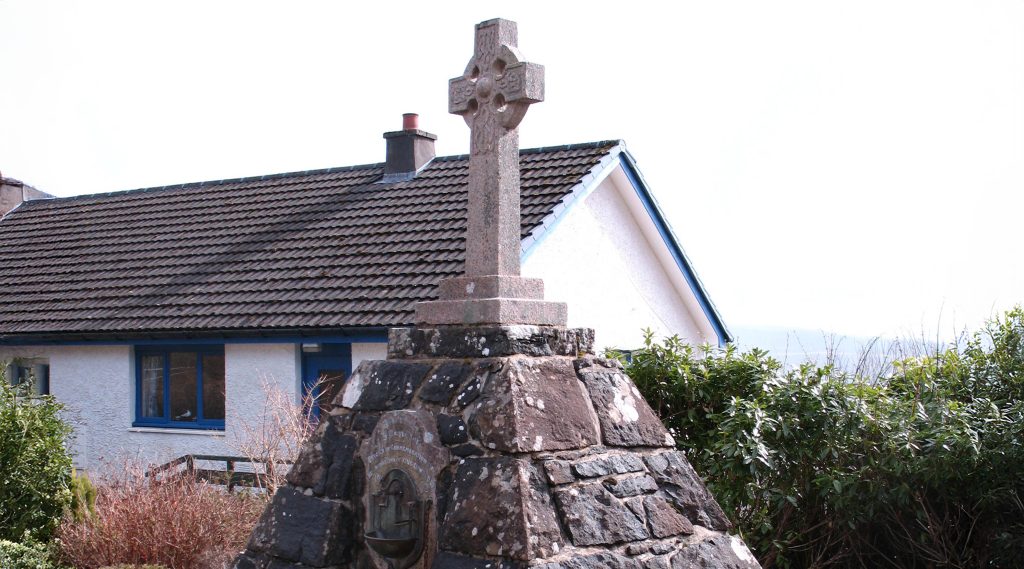
Everyone knows the Tobermory from the postcards: a colourful horseshoe of buildings wrapped around a sheltered bay. It’s a scene of vibrant houses and bobbing boats that has become an iconic symbol of Scotland. But to truly understand this charming town, you have to look beyond the surface and discover its real origin story—one not built with paint, but with water, faith, and ancient tradition.
That story begins with a humble spring known as Mary’s Well, or Tobar Mhoire in Gaelic, and its history is the very foundation of the town, giving Tobermory its name and its soul.
A Place of Ancient Reverence
Centuries before a single building lined the Tobermory seafront, this site was a place of deep spiritual significance. It was a holy well, a sacred spring dedicated to the Virgin Mary, and believed to hold remarkable healing powers. In ancient Celtic and pre-Christian traditions, wells and springs were revered as powerful conduits to the spiritual world. The practice of visiting these sites for healing and cleansing was a core part of the culture, and Mary’s Well became one of the most important in the region.

A Pilgrimage for the Faithful
Pilgrims from across the West Highlands would journey to the Isle of Mull, undertaking what was often a difficult and long pilgrimage, simply to drink from its waters or bathe in its restorative pools. This was not a trip for tourism, but a journey of profound faith and hope. The well’s importance was also tied to the presence of St. Mary’s Chapel, a medieval structure that stood nearby. Though only scattered stone remains of the chapel can be seen in the adjacent graveyard today, its existence underscores the area’s central role as a spiritual hub for the community. The Gaelic name, Tobar Mhoire, is a direct and permanent link to this spiritual past, a name that literally means “Mary’s Well.”
The Birth of a Town: A Blend of Industry and Spirituality
Fast forward to the late 1700s, when Tobermory as we know it began to take shape. The British Fisheries Society, a group dedicated to improving the fishing industry in the Highlands, identified the island’s natural, deep-water harbour as the perfect location for a new port. In 1788, they commissioned the renowned engineer Thomas Telford to design the new town. The project was ambitious and challenging. The area that is now the main street and harbour was a steep, rocky cliff face. Telford’s team had to undertake monumental engineering works, cutting into the hillside and reclaiming land from the sea to create the sheltered waterfront.
The Legacy of a Name
The new town was intended to be a hub for fishermen and merchants, attracting locals from the surrounding farms and settlements. Despite the focus on industry and trade, the town’s founders chose to honour its ancient spiritual past. They named the new settlement Tobermory, ensuring that the legacy of Tobar Mhoire would forever be woven into its identity. While the town’s early economic ambitions were often a struggle, with fishing not becoming as profitable as hoped and the short-lived kelp industry eventually collapsing, its name remained a constant reminder of its deep roots.
A Modern Monument to an Ancient Past
Today, the original medieval well has become overgrown and has faded into the landscape. But the legacy of Mary’s Well is preserved in a remarkable monument. In 1902, a distinctive granite cross and a working drinking fountain were erected in the upper part of the town to commemorate the coronation of King Edward VII. This monument stands on or very near the site of the original holy well.
Continuing a Timeless Tradition
Crucially, the fountain still flows with fresh water today. This allows modern-day visitors to symbolically partake in the ancient tradition, continuing a custom that dates back many centuries. It is a tangible and symbolic link between the town’s bustling present and its ancient, spiritual past. It is a quiet, reflective spot, a place to pause and consider the journey of this town, from a site of pilgrimage to a vibrant tourist destination.
For visitors, a trip to the monument of Mary’s Well offers a unique perspective. It’s a chance to step away from the colourful seafront and connect with the history that gave this special place its name. It’s a journey that reveals that Tobermory is more than just a beautiful harbour; it’s a place with a profound and enduring story, rooted in ancient traditions and a spiritual connection to the land. Finding this site is to find the true, quiet heart of Tobermory. It is a story well worth uncovering.

